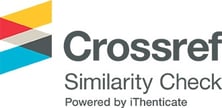Pengaruh Faktor Keuangan terhadap Financial Distress dengan dimoderasi oleh Komite Audit
DOI:
10.33395/owner.v6i3.867Keywords:
audit committee, current ratio, financial distress, MRA, operating cash flowAbstract
Research on the company's financial difficulties is very important because it can lead to bankruptcy which will have a bad impact on the country's economy. This study aims to provide empirical evidence about the influence of financial factors, namely operating cash flow per share (OCFS) and current ratio (CR) in predicting financial distress moderated by the expertise of the audit committee. This research is a quantitative study on property & real estate sector listed on the Indonesia Stock Exchange (IDX) in the 2015-2019 period. The number of samples as many as 36 companies from 73 populations was obtained through the purposive sampling technique. This study uses the Moderated Regression Analysis (MRA) method in analyzing the processed data using the SPSS application. The results showed that operating cash flow per share can reduce financial distress while the current ratio has no effect on financial distress. In addition, it was found that the expertise of the audit committee strengthens the relationship between operating cash flow per share and financial distress, but not the relationship between the current ratio and financial distress. This research is useful to provide insight to investor,company’s management, financial institutions, stakeholders and other related parties in future decision making.
Downloads
Plum-X Analityc
References
Almamy, J., Aston, J., & Ngwa, L. N. (2016). An evaluation of Altman’s Z-score using cash flow ratio to predict corporate failure amid the recent financial crisis: Evidence from the UK. Journal of Corporate Finance, 36, 278–285. https://doi.org/10.1016/j.jcorpfin.2015.12.009
Almeida, H., Campello, M., & Weisbach, M. S. (2004). The cash flow sensitivity of cash holdings. Advances in Environmental Biology, 7(14), 4795–4801. https://doi.org/10.1111/j.1540-6261.2004.00679.x.
Altman, E. I. (1968). Financial ratios, discriminant analysis and the prediction of corporate bankruptcy. The Journal of Finance, 23, 1777–1804. https://doi.org/10.2307/1882010.
Balasubramanian, S. A., Radhakrishna, G. S., Sridevi, P., & Natarajan, T. (2019). Modeling corporate financial distress using financial and non-financial variables: The case of Indian listed companies. International Journal of Law and Management, 61(3–4), 457–484. https://doi.org/10.1108/IJLMA-04-2018-0078
Bilal, Chen, S., & Komal, B. (2018). Audit committee financial expertise and earnings quality: A meta-analysis. Journal of Business Research, 84(November 2016), 253–270. https://doi.org/10.1016/j.jbusres.2017.11.048
Ciptawan, & Frandjaja, B. O. (2022). The Impact Of Current Ratio And Gross Profit Margin Towards Financial Distress In Technology Sector Companies Listed In Indonesia Stock Exchange For Period 2016-2020. Journal of Industrial Engineering & Management Research, 3, 197–214. https://doi.org/10.7777/jiemar.v3i1.293.
Creswell, J. W., & Creswell, J. D. (2018). Research Design: Qualitative, Quantitative, and Mixed Methods Approaches (5th Editio). UK: SAGE Publications Inc.
Cultrera, L., & Brédart, X. (2016). Bankruptcy prediction: The case of Belgian SMEs. Review of Accounting and Finance, 15(1), 101–119. https://doi.org/10.1108/RAF-06-2014-0059
Geng, R., Bose, I., & Chen, X. (2015). Prediction of financial distress: An empirical study of listed Chinese companies using data mining. In European Journal of Operational Research (Vol. 241). Elsevier B.V. https://doi.org/10.1016/j.ejor.2014.08.016
Ginting, M. C. (2017). Pengaruh Current Ratio dan Debt to Equity Ratio (DER) Terhadap Financial Distress pada Perusahaan Property & Real Estate di Bursa Efek Indonesia. Jurnal Manajemen, 3(2), 37–44. Retrieved from http://ejournal.lmiimedan.net/index.php/jm/article/view/12/12.
Ismoyo, B., & Arifin, C. (2021). Sekarang Masih Lesu, Sektor Properti Diprediksi Kembali Bergairah di 2022. Retrieved March 27, 2022, from https://www.tribunnews.com/bisnis/2021/07/14/sekarang-masih-lesu-sektor-properti-diprediksi-kembali-bergairah-di-2022.
Lee, J. E., Glasscock, R., & Park, M. S. (2017). Does the ability of operating cash flows to measure firm performance improve during periods of financial distress? Accounting Horizons, 31, 23–35. https://doi.org/10.2308/acch-51594.
Lord, J., Landry, A., Savage, G. T., & Weech-Maldonado, R. (2020). Predicting Nursing Home Financial Distress Using the Altman Z-Score. Inquiry (United States), 57. https://doi.org/10.1177/0046958020934946
Mohamed, S. S. (2020). Suggested Model for Explaining Financial Distress in Egypt: Toward a Comprehensive Model. 36, 99–122. https://doi.org/10.1108/s0196-382120200000036005
Nuresa, A., & Hadiprajitno, B. (2013). Pengaruh efektivitas komite audit terhadap financial distress. Diponegoro Journal of Accounting, 2, 1–10.
Permata, D., & Juliarto, A. (2021). Prediksi Financial Distress Menggunakan Variabel Keuangan Dan Variabel Non Keuangan. Diponegoro Journal of Accounting, 10, 1–13.
Qomarullah, M. Z., Kusumaningrum, R., & Widodo, C. E. (2017). Informating system of cash flow analysis for determining company’s health. Internation Journal of Computer Applications, 179, 30–34. https://doi.org/10.5120/ijca2017915925.
Ragab, Y. M., & Saleh, M. A. (2021). Non-financial variables related to governance and financial distress prediction in SMEs–evidence from Egypt. Journal of Applied Accounting Research, ahead-of-p(ahead-of-print). https://doi.org/https://doi.org/10.1108/JAAR-02-2021-0025
Restianti, T., & Agustina, L. (2018). The Effect of Financial Ratios on Financial Distress Conditions in Sub Industrial Sector Company. 7(1), 25–33. https://doi.org/10.15294/aaj.v5i3.18996
Salehi, M., Shiri, M. M., & Pasikhani, M. B. (2016). Predicting corporate financial distress using data mining techniques: An application in Tehran Stock Exchange. International Journal of Law and Management, 58(2), 216–230. https://doi.org/10.1108/IJLMA-06-2015-0028
Shrivastava, A., & Kumar, K. (2018). Business Distress Prediction Using Bayesian Logistic Model for Indian Firms. (1968). https://doi.org/10.3390/risks6040113
Spence, M. (1973). Job Market Signaling. The Quarterly Journal of Economics, 87(3), 355–374. https://doi.org/10.2307/1882010.
Sunaryo, D. (2021). Analysis Of Current Ratio, Debt To Assets Ratio And Gross Profit Margin On Financial Distress With Moderated Share Prices In Retail Companies Listed In Securities Exchange. International Journal of Educational Research & Social Sciences, 2(1), 23–33. https://doi.org/10.51601/ijersc.v2i1.39
Thanh, V. H., Ha, N. M., & Mcaleer, M. (2021). Asset Investment Diversification, Bankruptcy Risk and The Mediating Role of Business Diversification. Annals of Financial Economics, 16(01), 1–26. https://doi.org/10.1142/S2010495221500019
Zelie, E. M. (2019). Determinants of Financial Distress in Case of Insurance Companies in Ethiopia. Research Journal of Finance and Accounting, 10(15), 27–32. https://doi.org/10.7176/RJFA/10-15-05.
Downloads
Published
How to Cite
Issue
Section
License
Copyright (c) 2022 Anita Evrilianingsih, Annisa Shaffana Amalia

This work is licensed under a Creative Commons Attribution-NonCommercial 4.0 International License.
















